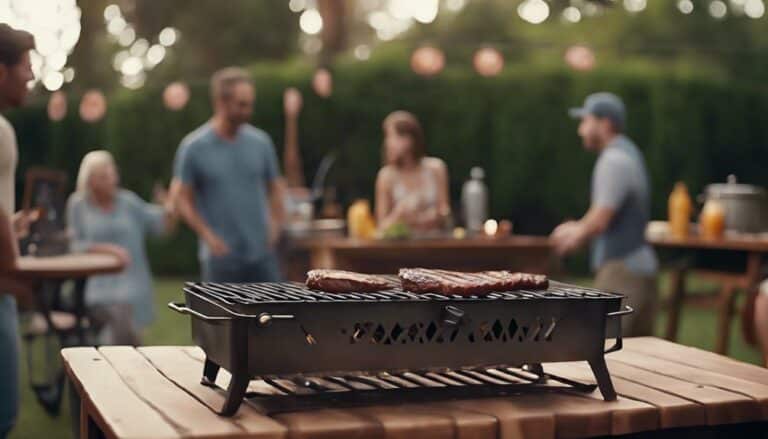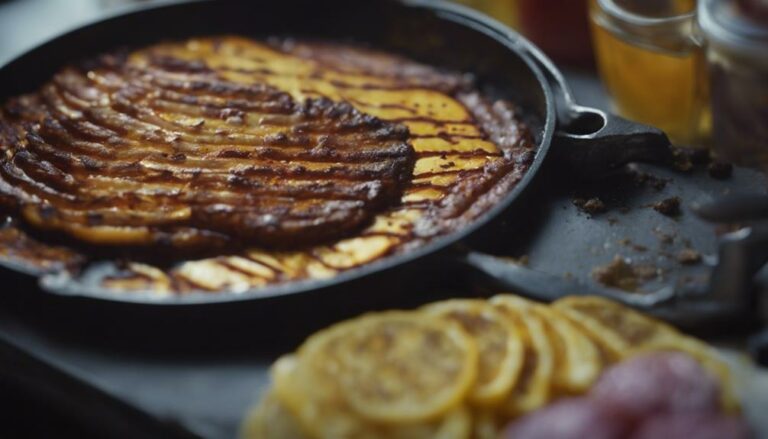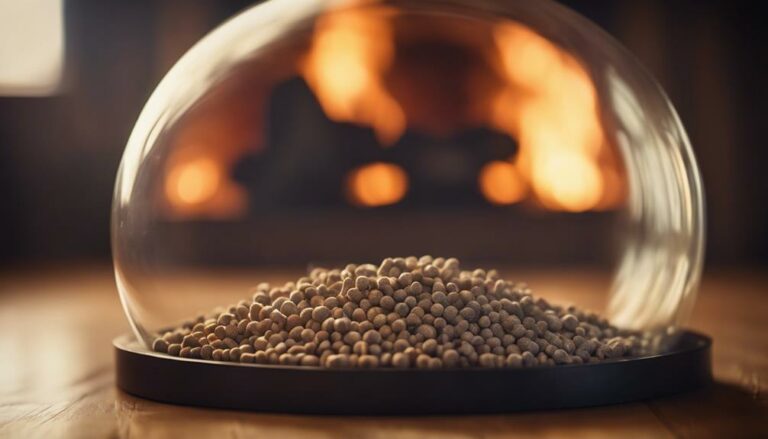I’m passionate about seafood grilling and I want to share my knowledge with you!
From selecting the right seafood to avoiding common grilling mistakes, I’ll tell you all you need to know to create deliciously cooked seafood dishes.
I’ll even share some of my favorite recipes.
So, if you’re ready to take your grilling skills to the next level, let’s get started!
Table of Contents
Key Takeaways
- Select seafood that is glossy, moist, and odorless, and ensure proper labeling and sealing when purchasing from grocery stores.
- Clean the seafood properly by removing scales, guts, and fins, and rinse it thoroughly under cold water before grilling.
- Consider marinating the seafood with ingredients like olive oil, lemon juice, garlic, and herbs to enhance its flavor and moisture.
- Preheat the grill to the appropriate temperature and avoid common grilling mistakes such as undercooking, overcooking, and lack of marinade.
Selecting the Right Seafood
Choosing the right seafood for grilling is key to achieving a perfectly cooked delicacy. When buying seafood, it’s important to select the freshest cuts. Look for seafood that’s glossy, moist, and odorless. If you’re purchasing seafood from a grocery store, make sure it’s properly labeled and sealed. If you’re buying seafood from a fishmonger, ask questions about the origin and quality of the catch.
It’s also important to select the right cut of seafood for the type of grilling you plan to do. For example, whole fish are best for open-fire grilling, while fillets are better suited for grates.
Taking the time to select the right seafood will ensure your grilled seafood is as delicious as possible.

Preparing Seafood for Grilling
Grilling seafood can be a delicious and rewarding experience. Before we get started, there are a few important steps to take to ensure the seafood comes out perfectly cooked.
First, it’s important to clean the fish properly. Remove any scales, guts, and fins, and rinse the fish thoroughly under cold water. Pat it dry with paper towels to remove excess moisture.
Next, consider marinating the seafood to enhance its flavor. You can create a simple marinade using ingredients like olive oil, lemon juice, garlic, and herbs. Let the seafood marinate for at least 30 minutes to allow the flavors to penetrate the flesh.
Lastly, preheating the grill is crucial for achieving perfect results. Heat the grill to medium-high heat, allowing it to reach a temperature of around 400-450 degrees Fahrenheit. This will ensure that the seafood cooks evenly and develops a nice sear on the outside.
Cleaning Fish
Cleaning fish is an important step in the process of grilling seafood delicacies. Before you even buy the seafood, make sure to research the best places to find high-quality, fresh fish.
Once the fish is purchased, it’s important to properly fillet it. By doing so, you can remove any scales or bones that could cause issues when grilling. To ensure a smooth filleting process, make sure to use a sharp, flexible blade, and keep your fingers away from the blade. Have a steady grip on the fish too, and make sure to use a cutting board specifically for seafood.
After the filleting is complete, rinse the fish with cold water and pat it dry with paper towels. This important step will ensure that your seafood is ready for the grill!
Marinating Seafood
Marinating seafood before grilling it adds a delicious layer of flavor that can’t be beat! Whether you’re looking for something simple or complex, there are endless flavor combinations you can choose from. I love experimenting with a variety of herbs, spices, and oils to find the perfect marinade.
- Herbs & Spices
- Rosemary
- Thyme
- Garlic
- Chili powder
- Paprika
- Oils
- Olive
- Coconut
- Sunflower
- Avocado
No matter what flavor combination you choose, it’s important to follow the right marinating times. Most seafood can marinate anywhere from 30 minutes to up to 12 hours, so be sure to check the instructions for the specific seafood you’re cooking.
With the right marinade, your seafood will come out perfectly cooked and full of flavor!
Preheating Grills
Before grilling any type of food, it’s important to preheat your grill to ensure optimal cooking. To get the best results, the grill should be preheated to a temperature of 400-450°F. This ensures that the food will be cooked through and the outside will be nicely browned.
For gas grills, it’s best to keep one burner on high and the other on low. This creates a two-zone cooking area, where you can sear the food on the high-heat side and then move it to the low-heat side to finish cooking. This prevents the food from burning on the outside while still being raw on the inside.
For charcoal grills, it’s important to select the right charcoal, as different types will vary in heat intensity. Lump charcoal tends to burn hotter and faster, while briquettes burn more slowly and evenly. Choose the type that suits your cooking needs.
When the charcoal is lit, spread it out evenly across the bottom of the grill. Wait until the coals are covered in a layer of gray ash before cooking. This indicates that the charcoal is fully heated and ready for grilling.
Once the desired temperature is reached, use a thermometer to check the temperature if necessary. This will ensure that you have an accurate reading and can adjust the heat accordingly.
Preheating the grill is a crucial step towards seafood grilling mastery! It ensures that your food cooks evenly and thoroughly, resulting in delicious meals every time. So don’t skip this important step and enjoy the flavors of perfectly grilled seafood.
Setting Up the Grill
The first step to perfectly cooked seafood delicacies is setting up your grill. Choosing the right tools for the job is essential to success. Here are two important things to consider:
- Charcoal Selection:
- If you’re using charcoal, be sure to select a quality brand. The size and shape of your charcoal can affect the heat control.
- Heat Control:
- Be sure to adjust the vents and grates to the desired temperature. This will help ensure even cooking and prevent burning.
Grilling Techniques and Tips
Knowing the right grilling techniques is key to achieving delicious results. To become a seafood grilling master, you should be aware of the correct cooking temperatures, grilling times, and the type of grill you’re using.
| Temperature (F) | Grill Times (minutes) | Grill Type |
|---|---|---|
| 350-400 | 8-10 | Gas |
| 400-450 | 4-6 | Charcoal |
| 450+ | 1-2 | Electric |
These temperatures and times will vary depending on the type of seafood you’re cooking, as well as the size and thickness of the pieces. To ensure that your seafood is cooked to perfection, always use a meat thermometer to check for doneness. Additionally, marinading your seafood before grilling will add flavor and moisture, and prevent it from drying out. Finally, be sure to keep the grill clean and well-oiled to prevent sticking. With these tips and techniques, you’ll be grilling perfect seafood in no time!
Common Grilling Mistakes to Avoid
As a griller, I’ve experienced my share of mistakes, and I want to help others avoid them.
Common grilling mistakes to avoid include:
- Timing Mistakes:
- Overcooking: keep a close eye on the grill and use a thermometer to test the internal temperature of the seafood.
- Undercooking: double check the doneness of the seafood to make sure it’s properly cooked.
- Seasoning Mistakes:
- Too Much Salt: be mindful when seasoning seafood, as too much salt can overwhelm the delicate flavors.
- Not Enough Flavor: add spices, herbs, and other flavorful ingredients to enhance the natural flavors of the seafood.
Grilling seafood delicacies requires precision, practice, and patience. With the right techniques and tools, and by avoiding common grilling mistakes, you can become a master of the art of seafood grilling.
Serving Grilled Seafood
Now that I’ve mastered the art of grilling seafood, it’s time to move onto the next step – serving it.
I’m no stranger to proper etiquette when it comes to serving meals, so I make sure to use the right plates, utensils, and even pairings.
For example, I always serve grilled seafood with light, acidic wines, like Sauvignon Blanc. It helps to bring out the flavor of the fish, and also compliments the spices I’ve added.
Additionally, I’m careful to provide a few different condiments, as they help to enhance the taste.
All in all, I’m confident in my ability to provide a delicious meal that everyone will enjoy.
Cleaning and Storing the Grill
After serving my guests, I take the time to clean and store my grill so that it’s ready for the next time I want to make delicious grilled seafood. To ensure a successful cleanup, I:
- Clean the grill grate:
- Scrape off charred bits using a stiff wire brush
- Wipe the grate down with a paper towel
- Baste it with oil and seasonings to prevent rust
- Clean the interior of the grill:
- Scrub the inside with a damp rag
- Remove ash and other debris
- Refill with fresh charcoal or gas
I take pride in keeping my grill clean and in prime condition for basting seafood and seasoning food.
My guests appreciate my commitment to perfecting the art of grilling seafood delicacies.

Recipes for Delicious Grilled Seafood Dishes
Now that the grill is all set up and ready to go, it’s time to explore the amazing world of grilled seafood dishes!
From the classic fish tacos to grilled shrimp skewers, there are endless possibilities when it comes to creating delicious seafood dishes right from your own backyard.
Types of Seafood
I’m passionate about grilling seafood and familiarizing myself with the many types of fish and shellfish available.
When it comes to grilling seafood, there are a few things to consider:
- Fish:
- Salmon
- Tilapia
- Trout
- Shellfish:
- Clams
- Oysters
- Mussels
The key to successful grilling is to use the right temperature for each type of seafood. For fish, the recommended temperature is 350-400°F. For shellfish, the temperature should be lower, around 300°F. It’s also important to remember that shellfish varieties require pre-cooking before grilling.
I’m passionate about grilling seafood and learning the best approaches to cooking each type of fish and shellfish deliciously. With the right knowledge and a bit of practice, I’m sure anyone can become a master of seafood grilling.
Grilling Techniques
With experience comes the ability to create grilled seafood delicacies with ease.
Charcoal grilling and wood smoking are two great methods to use for seafood.
Charcoal grilling involves placing the seafood on a grill over the hot coals. This will give the seafood a smoky flavor and a nice grilled texture.
Wood smoking, on the other hand, requires the seafood to be placed directly on the wood chips and then cooked slowly. This will give the seafood a rich smoky flavor and a soft texture.
Both methods are delicious and can be used in a variety of dishes.
The key is to find the right balance of heat and smoke to create the perfect grilled seafood delicacy.
How Can I Incorporate Plant-Based Options into my Seafood Grilling?
Looking to add some variety to your seafood grilling? Consider incorporating plant-based options into your BBQ recipes. Enhance your grilling experience with flavorful vegan or vegetarian alternatives that can complement your favorite seafood dishes. With grilling plant-based bbq recipes, you can create unique and delicious combinations that will satisfy all your cravings.
Frequently Asked Questions
What Type of Grill Is Best for Seafood?
I prefer a charcoal grill for seafood because of its ability to get hotter than other types of grills, allowing for better marinating techniques and higher grilling temperatures.
Is There a Difference Between Grilling and Barbecuing Seafood?
Grilling and barbecuing seafood have distinct differences; temperature and marinade time are key. Grill temps should be lower than BBQing, with shorter marinade times. Grilling can also bring out a smoky flavor, which BBQing can’t.
What Are the Health Benefits of Eating Grilled Seafood?
Grilling seafood offers numerous health benefits, such as reduced fat and cholesterol content and increased protein. Marinade options add flavor while preserving nutrients, and grilled nutrition is higher than other cooking methods. It’s a tasty and nutritious way to enjoy seafood!
What Kind of Seasoning Should I Use to Bring Out the Flavor of Grilled Seafood?
I love using marinades and grilling rubs to bring out the flavor of grilled seafood. They add depth and complexity to the dish, making it truly delicious. Experiment with different seasonings to find the perfect combination for your tastes.
Should I Use Butter or Oil to Prevent Seafood From Sticking to the Grill?
I recommend using oil or marinades with spice rubs to prevent seafood from sticking to the grill. These will help infuse flavor to the fish while also keeping it moist and prevent it from sticking.
Conclusion
Grilling seafood can be an art, but with a few tips and a little practice, anyone can become a master.
Once you’ve selected the right seafood, prepped it correctly, and set up your grill, you can start to experiment with grilling techniques.
I’m passionate about sharing my knowledge, so don’t be afraid to try something new!
With proper cleaning and storage of your grill, you’ll be able to enjoy perfect seafood dishes time and again.










